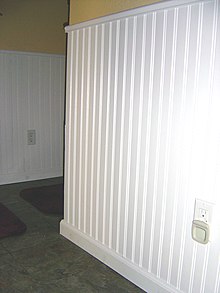利用者:加藤勝憲/羽目板

パネリングとは、硬質または半硬質の部材で構成された造作壁材のことである[1]。これらは伝統的に木材を連結したものであるが、プラスチックやその他の素材のこともある。
パネリングは古代、石造りの建物の部屋をより快適にするために開発されたもので、石から部屋を断熱し、薪ストーブからの輻射熱を反射して、室内の熱をより均等にする。より近代的な建物では、このようなパネリングは装飾目的で設置されることが多い。 特に羽目板やボワズリーなどのパネリングは、非常に華麗な装飾が施されることがあり、特に17世紀や18世紀のインテリアデザイン、イギリスのヴィクトリア朝建築、そして同時代の国際的な建築に関連している。
腰板パネル
[編集]
ウェインスコット(イギリス: [ˈweɪnskət] WAYN-skət、またはアメリカ: [ˈweɪnskɒ] WAYN-skot)という用語は、もともとは高品質のオーク材の柾目の板を指す。
The term wainscot (イギリス: [ˈweɪnskət] WAYN-skət or アメリカ: [ˈweɪnskɒt] WAYN-skot) originally applied to high quality riven oak boards.
ウェインスコットオーク材は、ゆっくりと成長する森林の大木から産出され、節がなく、タンニンが少なく、軽量で加工しやすい板材であった。特にオランダやイギリス諸島では、国産のオーク材よりもはるかに優れた製品で寸法も安定していたため、好まれた。
オックスフォード英語辞典は、中低地ドイツ語のwagenschotに由来し、またwageschotまたは「壁板」にも由来すると述べている[2]。 ジョンソン辞典はこのように定義している:
The Oxford English Dictionary states that it derives from the Middle Low German wagenschot as well as wageschot or 'wall-board'. Johnson's Dictionary defined it thus:
The term wainscoting, as applied to the lining of walls, originated in a species of foreign oak of the same name, used for that purpose; and although that has long been superseded by the introduction of fir timber, the term has been continued notwithstanding the change of material.[3]—Peter Nicholson、An Architectural Dictionary (1819)
A 'wainscot' was therefore a board of riven (and later quarter-sawn) oak, and wainscoting was the panelling made from it. During the 18th century, oak wainscot was almost entirely superseded for panelling in Europe by softwoods (mainly Scots pine and Norway spruce), but the name stuck:
Wainscot [wageschot, Dutch], the inner wooden covering of a wall.
To wainscot [waegenschotten, Dutch], to line the walls with boards
Today the term wainscot refers commonly to the different treatment of the lower part of the wall (roughly a meter, 3–4 feet); see also dado.
Boiserie
[編集]
Boiserie (フランス語発音: [bwazʁi]フランス語発音: [bwazʁi]フランス語発音: [bwazʁi]; often used in the plural boiseries) is the French term used to define ornate and intricately carved wood panelling.[4] Boiseries became popular in the latter part of the 17th century in French interior design, becoming a de rigueur feature of fashionable French interiors throughout the 18th century. Such panels were most often painted in two shades of a chosen color or in contrasting colors, with gilding reserved for the main reception rooms.[5] The Palace of Versailles contains many fine examples of white painted boiseries with gilded mouldings installed in the reigns of Louis XV and Louis XVI. The panels were not confined to just the walls of a room but were used to decorate doors, frames, cupboards, and shelves also. It was standard for mirrors to be installed and framed by the carved boiseries, especially above the mantelpiece of a fireplace. Paintings were also installed within boiseries, above doorways or set into central panels.[6]
関連項目
[編集]- Moulding (decorative)
- Ornament (art)
- Panel edge staining
- Structural insulated panel
- Vacuum insulated panel
- Crown moulding
- Dado (architecture)
- Dado rail
- Woodie (car body style)
- Wall panel
References
[編集]- ^ “Paneling”. Encyclopædia Britannica. britannica.com. 11 January 2016閲覧。
- ^ “wainscot”. Oxford Dictionaries (9 September 2017). September 9, 2017時点のオリジナルよりアーカイブ。 Template:Cite webの呼び出しエラー:引数 accessdate は必須です。
- ^ Peter Nicholson, An Architectural Dictionary, 2 Vols., London (1819).
- ^ Garay (June 23, 2014). “The Beauty of Boiserie”. paintandpattern.com. 11 January 2016閲覧。
- ^ Whitehead, John (1992). The French Interior in the 18th Century. Dutton Studio Books. pp. 95–7
- ^ Whitehead, John (1992). The French Interior in the 18th Century. Dutton Studio Books. pp. 95–7
外部リンク
[編集]Template:Wood productsTemplate:Woodworking [[Category:木工]] [[Category:建築]] [[Category:建築材料]] [[Category:建築工法]]
